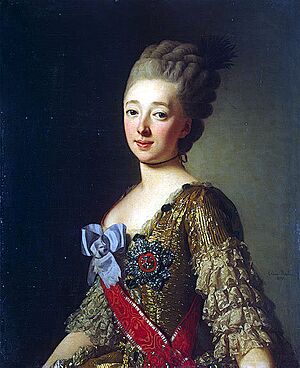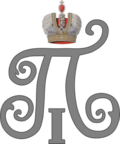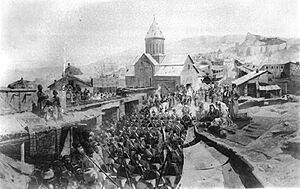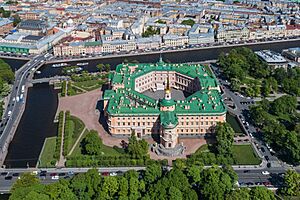Paul I of Russia facts for kids
Quick facts for kids Paul I |
|||||
|---|---|---|---|---|---|

Portrait by Vladimir Borovikovsky, 1800
|
|||||
| Emperor of Russia | |||||
| Reign | 17 (6) November 1796 – 23 (11) March 1801 | ||||
| Coronation | 5 (16) April 1797 | ||||
| Predecessor | Catherine II | ||||
| Successor | Alexander I | ||||
| Duke of Holstein-Gottorp | |||||
| Reign | 9 July 1763 – 23 (11) March 1801 | ||||
| Born | 1 October [O.S. 20 September] 1754 Saint Petersburg, Russian Empire |
||||
| Died | 24 March 1801 (aged 46) St Michael's Castle, Saint Petersburg, Russian Empire |
||||
| Burial | Peter and Paul Cathedral | ||||
| Spouse |
|
||||
| Issue detail |
|
||||
|
|||||
| House | Romanov-Holstein-Gottorp | ||||
| Father | Peter III of Russia | ||||
| Mother | Catherine II of Russia | ||||
| Religion | Russian Orthodox | ||||
| Signature |  |
||||
Paul I (born Pavel Petrovich Romanov; 1754–1801) was the Emperor of Russia from 1796 until he was murdered in 1801. For most of his life, Paul was overshadowed by his powerful mother, Catherine the Great. He created new rules for who would inherit the Russian throne. These rules, called the Pauline Laws, lasted until the end of the Romanov dynasty and the Russian Empire. Paul also got involved in the French Revolutionary Wars. Towards the end of his rule, he added parts of Eastern Georgia to the empire. His son, Alexander I, later confirmed this.
Paul was also the leader of the Knights Hospitaller from 1799 to 1801. He ordered many buildings for this group. Paul's love for German traditions and his unpredictable actions made him unpopular with the Russian nobility. Sadly, he was secretly murdered by his own officers.
Contents
Paul I's Early Life and Childhood
Paul was the son of Emperor Peter III and Catherine II. His great-aunt, Empress Elizabeth, took him away almost immediately after he was born. This meant he had very little contact with his mother.
As a boy, Paul was said to be smart and good-looking. However, he was often sick. A serious illness in 1771, called typhus, changed his face. Paul was put in the care of a trusted governor, Nikita Ivanovich Panin, and other good teachers. One of his teachers said he was "always in a hurry." He would act and speak without thinking first.
Paul I's Time Under Catherine the Great
Empress Elizabeth died in 1762, when Paul was eight years old. His father became Emperor Peter III, making Paul the crown prince. But within months, Paul's mother, Catherine, took power in a coup. She removed her husband from the throne. It was believed for a long time that her supporters killed him. Later, it was found that Peter III likely died from a stroke during an argument. After Peter III's death, Catherine became Empress. The 8-year-old Paul remained the Tsesarevich, or heir to the throne.
In 1772, Paul turned eighteen. He and his advisor, Panin, believed Paul should be the rightful tsar. Catherine wanted to distract him. She found Paul a wife, Princess Wilhelmina of Hesse-Darmstadt. She took the Russian name "Natalia Alexeievna." Catherine allowed Paul to attend government meetings to prepare him for being Emperor. Sadly, Wilhelmina and their baby died during childbirth in 1776.
It became clear to Catherine that Paul wanted power. There was talk of them ruling Russia together, but Catherine avoided it. A strong rivalry grew between them. Catherine knew she could not truly trust her son. Paul wanted his mother's position, and by the rules then, it was his.
After his first wife died, Catherine quickly found Paul another wife. On October 7, 1776, Paul married Sophia Dorothea of Württemberg. She became Maria Feodorovna. Their first child, Alexander, was born in 1777. Catherine gave Paul an estate called Pavlovsk. In 1783, she gave him another estate, Gatchina Palace. There, he kept soldiers and trained them in the Prussian style.
Paul's Relationship with Catherine the Great
Catherine and Paul had a distant relationship. Empress Elizabeth had taken Paul as a baby. She was very focused on him but not a good caregiver. Paul was looked after by many different people. One time, he fell out of his crib and slept on the floor without anyone noticing.
Even after Elizabeth died, his relationship with Catherine did not get better. Paul was often jealous of the gifts she gave to her favorites. Once, she gave a favorite 50,000 rubles for her birthday. Paul only received a cheap watch. Paul's early separation from his mother created a distance that never went away. She never thought about sharing her power with him. When Paul's son Alexander was born, Catherine seemed to prefer him as the next ruler.
Paul openly disagreed with his mother's policies. He wrote a paper called Reflections criticizing her military plans. He argued for a more defensive army instead of wars that expanded the empire. Catherine did not like this. She saw it as a threat to her power.
Paul spent the next years away from the Imperial Court. He stayed at his private estates with his family. He enjoyed drilling his soldiers. As Catherine got older, she focused mostly on Paul's son, Alexander. She even thought about making Alexander the next Emperor instead of Paul. She talked secretly with Alexander's tutor about this. But Alexander respected his father's right to be the next ruler.
Paul I Becomes Emperor
Catherine suffered a stroke on November 17, 1796, and died. Paul's first action as Emperor was to find and destroy her will. He feared it would prevent him from becoming emperor and give the throne to Alexander. These fears may have led Paul to create the Pauline Laws. These laws made it clear that the oldest male heir would always inherit the throne.
Paul immediately called back the army that Catherine had sent to attack Persia. He also ordered his father's remains to be moved to the Saints Peter and Paul Cathedral, Saint Petersburg. This is where the Romanov family was buried. Count Alexei Orlov, who may have been involved in Peter III's death, was made to walk in the funeral procession. He had to carry the Imperial Crown in front of Peter's coffin. Peter III had never been crowned. So, Paul personally performed a coronation ritual on his father's remains. Paul wanted to show that he was a true descendant of Peter the Great. A monument to Peter the Great near St. Michael's Castle reads: "To the Great-Grandfather from the Great-Grandson."
Paul I's Unique Personality and Reforms
Paul was a man of strong ideas and could be very generous. But he was also moody and could hold grudges. He was very much like his father, Peter III. In his first year as emperor, Paul changed many of his mother's policies. He allowed some of Catherine's critics to return from exile. He believed the Russian nobility had become lazy and corrupt. He wanted to make them disciplined and loyal, like knights from old times.
Paul tried to reform the Imperial Russian Army in ways that were not popular. Under Catherine, soldiers wore comfortable uniforms. Paul decided to bring back the Prussian-style uniforms. These were not practical for fighting and were hard to keep clean. Soldiers did not like them.
Paul also loved parades and ceremonies. He ordered "Watch parades" every morning, no matter the weather. He would personally punish soldiers for mistakes. Once, he ordered a Guards regiment to march to Siberia for being out of order during training. He changed his mind after they had walked about 10 miles. He also spent a lot of money building three palaces.
Paul I's Foreign Policy
Paul's early foreign policy was often the opposite of his mother's. He did not like the many wars she fought to expand the empire. Instead, he wanted a more peaceful approach. When he became emperor, he called back all troops from outside Russia. This included troops sent to Persia and those promised to Britain and Austria to fight the French. Paul disliked the French, especially after their revolution. He felt their ideas were dangerous. He also believed Russia needed to fix its own government and army before fighting wars abroad.
Paul offered to help Austria and France make peace. But they made peace without him in October 1797. This treaty upset Paul because it gave France control over islands in the Mediterranean. He saw this as a sign of France's growing power. In response, he offered a safe place to French princes who had been forced out of Austria. By this time, France had taken over Italy, the Netherlands, and Switzerland. Paul felt Russia needed to act to stop France and bring back the old monarchies. Britain and the Ottoman Empire joined Russia and Austria to stop France. Only Prussia did not join this group, called the Second Coalition. Paul decided to go ahead with the war.
Another reason Paul decided to fight France was the island of Malta. Malta was home to the Knights Hospitaller. Paul had read about the Knights as a child and admired their honor. In 1798, Napoleon seized Malta. This greatly angered Paul. In September, the Knights declared that their leader had betrayed them by selling Malta to Napoleon. A month later, they elected Paul as their Grand Master. This was unusual because Paul was Orthodox, and the Order was Catholic. But it gave Paul another reason to fight France: to get back the Knights' home.
The Russian army helped the Austrians in Italy. A great Russian general, Alexander Suvorov, led all the allied armies. Under Suvorov, they pushed the French out of Italy. However, problems began between Russia and Austria. Paul and Suvorov wanted to free Italy and bring back its old rulers. The Austrians, however, wanted to gain land in Italy. The Austrians sent Suvorov's army out of Italy in 1799. They were supposed to meet another Russian army in Switzerland. But the Austrians left Switzerland before the Russian armies could join. This allowed the French to attack the Russian armies one by one. Suvorov's army suffered heavy losses. Suvorov and Paul blamed the Austrians for this defeat. This, along with Austria's actions in Italy, ended the alliance in October 1799.
Paul still worked with the British. They planned to invade the Netherlands and then attack France. The Anglo-Russian invasion of Holland started well. But when the Russian army arrived, they faced bad weather and strong resistance. The allies suffered many losses and signed a truce in October 1799. The Russians had three-quarters of the allied losses. The British then left the Russian troops on the Isle of Wight. This strained relations.
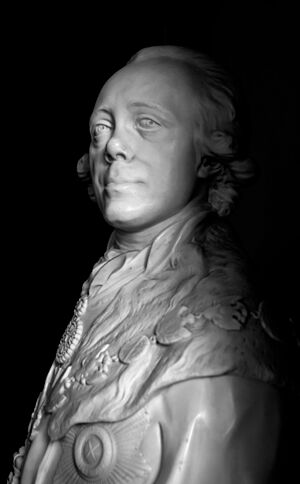
Two events finally broke the alliance. First, in July 1800, the British seized a Danish ship. Paul responded by closing British trading posts in Russia and seizing British ships. Second, when the British captured Malta from the French, Paul was angry that they did not return it to the Knights. He seized all British ships in Russian ports and held British traders hostage. He then formed a new group, the Armed Neutrality coalition, with Sweden, Denmark, and Prussia. This group aimed to protect Baltic trade from British attacks. Britain relied heavily on imports. They felt very threatened and reacted quickly. In March 1801, Britain sent a fleet to Denmark and attacked Copenhagen.
Paul I also decided to send a Cossack army to attack British India. Britain was hard to attack directly because it was an island with a strong navy. But India was not well guarded. Paul wanted to attack Britain where it was weakest: its trade and colonies. Throughout his rule, Paul wanted to bring peace and balance to Europe. He supported strong rulers and old monarchies, without trying to expand Russia's borders.
Russia and Georgia
After Russia did not keep its promises in a treaty, Iran invaded Georgia again. Tbilisi was captured and burned. But the Iranian ruler was killed in 1797. This weakened Iran's control over Georgia. In 1801, Tsar Paul I signed a law that made Georgia (Kartli-Kakheti) part of the Russian Empire. His son, Alexander I, confirmed this later that year.
Paul I's Assassination
Paul had a feeling he might be murdered. His attempts to make the nobility follow a strict code of conduct angered many of his advisors. The Emperor also found a lot of cheating and corruption in the Russian treasury. He had also made reforms that gave more rights to peasants. Many of his policies greatly annoyed the nobility. This led his enemies to plan against him.
A group of dismissed officers organized a plot. This included General Levin August, Count von Bennigsen and General Vladimir Mikhailovich Yashvil. On the night of March 23, 1801, they murdered Paul at the newly finished Saint Michael's Castle. They first tried to make him sign away his power, but Paul resisted. Paul's son, Alexander, who was 23, was in the palace when his father was killed. Alexander had agreed to remove Paul from power, but he did not expect him to be murdered. Alexander I did not punish the assassins.
Paul I's Family
Paul and his second wife, Maria Feodorovna, had ten children. Nine of them lived to adulthood.
| Name | Birth | Death | Notes |
|---|---|---|---|
| Alexander I, Emperor of Russia | 12 December 1777 | 19 November 1825 | Married Luise Auguste, Princess of Baden. They had two daughters who died as children. |
| Grand Duke Constantine of Russia | 27 April 1779 | 15 June 1831 | Married twice. |
| Grand Duchess Alexandra Pavlovna | 9 August 1783 | 16 March 1801 | Married Joseph, Archduke of Austria. She died in childbirth. |
| Grand Duchess Elena Pavlovna | 13 December 1784 | 24 September 1803 | Married Friedrich Ludwig. They had two children. |
| Grand Duchess Maria Pavlovna | 4 February 1786 | 23 June 1859 | Married Karl Friedrich. They had four children. |
| Grand Duchess Catherine Pavlovna | 21 May 1788 | 9 January 1819 | Married twice. She had two sons and two daughters. |
| Grand Duchess Olga Pavlovna | 22 July 1792 | 26 January 1795 | Died at age 2 from a tooth infection. |
| Grand Duchess Anna Pavlovna | 7 January 1795 | 1 March 1865 | Married Willem II, King of the Netherlands. They had five children. |
| Nicholas I, Emperor of Russia | 25 June 1796 | 18 February 1855 | Married Charlotte, Princess of Prussia. They had seven children. |
| Grand Duke Michael Pavlovich | 8 February 1798 | 9 September 1849 | Married Charlotte, Princess of Württemberg. They had five daughters. |
Images for kids
-
Military Parade of Emperor Paul in front of Mikhailovsky Castle painting by Alexandre Benois


